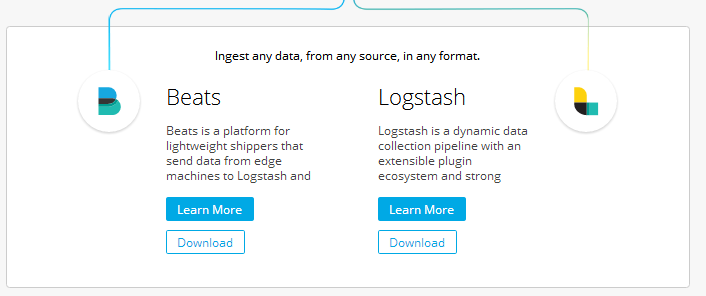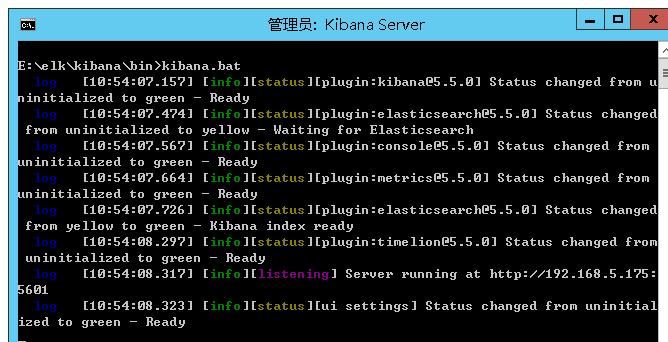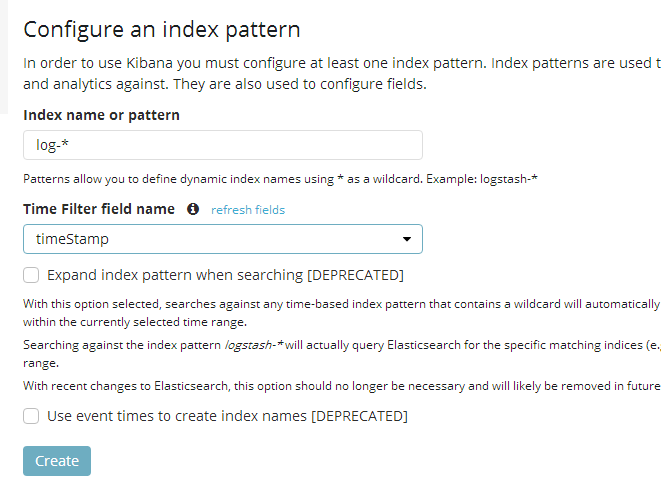ELK日志框架(2):log4net.ElasticSearch+ Kibana实现日志记录和显示
环境说明
1. windows server 2012 R2 64位
2. log4net.ElasticSearch
3. kibana-5.5.0-windows-x86.zip
架构说明
数据采集有两种方案Beats或Logstash,Logstash支持很多种数据源,有log4j但没有log4net,本想使用log4net.redis+redis+logstash的方式实现日志收集。无意间发现了 log4net.ElasticSearch可以直接写日志到ES,经过测试非常好用、方便。

log4net.ElasticSearch is a module for the log4net library to log messages to the ElasticSearch document database. ElasticSearch offers robust full-text searching an analyzation so that errors and messages can be indexed quickly and searched easily.
Features:
- Supports .NET 4.0+
- Easy installation and setup via Nuget
- Full support for the Elasticsearch _bulk API for buffered logging
安装kibana
1.下载kibana
首先下载windows版本的kibana文件,地址:https://artifacts.elastic.co/downloads/kibana/kibana-5.5.0-windows-x86.zip,解压到E:\elk\kibana目录
2.配置Kibana
打开配置文件E:\elk\kibana\config\kibana.yml,修改server.host和server.host,如下:
server.host: "192.168.5.175" elasticsearch.url: "http://192.168.5.175:9200"
3.运行Kibana
命令行下执行E:\elk\kibana\bin\kibana.bat文件

使用log4net.ElasticSearch
1.安装log4net.ElasticSearch
log4net.ElasticSearch可以通过Nuget安装,要注意保持和正在使用的log4net版本一致
Install-Package log4net.ElasticSearch -Version 2.3.4
log4net.ES.Example是一个测试Demo,修改配置后就能使用。
2.配置log4net.config文件
<!-- Default style appender. You can change the name but make sure you reference it corectly. Change the type if you're using .NET 4.0 --> <appender name="ElasticSearchAppender" type="log4net.ElasticSearch.ElasticSearchAppender, log4net.ElasticSearch"> <layout type="log4net.Layout.PatternLayout,log4net"> <param name="ConversionPattern" value="%d{ABSOLUTE} %-5p %c{1}:%L - %m%n" /> </layout> <!-- You can also use scheme, user, password here if you need https and http authentication, see the docs --> <connectionString value="Server=192.168.5.175;Index=log;Port=9200;rolling=true"/> <!-- false means do not eject older messages when the buffer is full, try to keep them all. --> <lossy value="false" /> <!-- Any buffer > 1 will use the Elasticsearch _bulk API. Tune as needed depending on how high volume your app is and how fast you want messages to show up in ES --> <bufferSize value="1" /> <!-- When an event comes in that matches or is above the treshold, the buffer will flush. I don't reccommend setting to "ALL" or it will defeat the purpose of having a buffer --> <evaluator type="log4net.Core.LevelEvaluator"> <threshold value="ALL"/> </evaluator> </appender>
Index=log:索引的名字
rolling=true:每天生成一个索引,比如log-2017.07.13
bufferSize :批量提交到ES,这里为了演示设置成1
<!-- Common to all log4net configs. See log4net docs for more details -->
<root>
<level value="ALL"/>
<appender-ref ref="ElasticSearchAppender" />
</root>
2.写入日志
运行测试程序,即可写入几条日志到ES中。
--查询索引列表
http://192.168.5.175:9200/_cat/indices
返回值:
yellow open log-2017.07.13 UBT3YG2qQpWkfJKRNw-XCQ 5 1 1 0 16.5kb 16.5kb
yellow open log-2017.07.07 pMXjGKkiRRSsrBdl5qNlNw 5 1 4 0 62.6kb 62.6kb
--查询索引内容
http://192.168.5.175:9200/log-2017.07.13/_search?q=*
返回值:
{
"took": 1,
"timed_out": false,
"_shards": {
"total": 5,
"successful": 5,
"failed": 0
},
"hits": {
"total": 1,
"max_score": 1,
"hits": [
{
"_index": "log-2017.07.13",
"_type": "logEvent",
"_id": "AV05k9nbXp-PycfFP2XN",
"_score": 1,
"_source": {
"timeStamp": "2017-07-13T01:32:53.9948595Z",
"message": "System Error",
"messageObject": {},
"exception": {
"Type": "System.Exception",
"Message": "Something terrible happened.",
"HelpLink": null,
"Source": null,
"HResult": -2146233088,
"StackTrace": null,
"Data": {},
"InnerException": null
},
"loggerName": "log4net.ES.Example.Program",
"domain": "log4net.ES.Example.exe",
"identity": "",
"level": "ERROR",
"className": "log4net.ES.Example.Program",
"fileName": "F:\\soft\\elk\\log4net.ES.Example-master\\log4net.ES.Example\\Program.cs",
"lineNumber": "18",
"fullInfo": "log4net.ES.Example.Program.Main(F:\\soft\\elk\\log4net.ES.Example-master\\log4net.ES.Example\\Program.cs:18)",
"methodName": "Main",
"fix": "LocationInfo, UserName, Identity, Partial",
"properties": {
"log4net:Identity": "",
"log4net:UserName": "BJ-BL\\Administrator",
"log4net:HostName": "BJ-BL",
"@timestamp": "2017-07-13T01:32:53.9948595Z"
},
"userName": "BJ-BL\\Administrator",
"threadName": "1",
"hostName": "BJ-BL"
}
}
]
}
}
日志字段非常全。。。。很赞
配置kibana
1.创建索引模式
打开kibana,http://192.168.5.175:5601。
点击Management=>Index Patterns=>Create Index Pattern,输入log-*就可以匹配上log-yyyy.mm.dd的索引了。

2.查询日志
点击Discover,选中log-*索引,就可以查询日志了。

总结
ELK日志框架已经搭建完成,这里的L变成了Log4net,ES和Kibana的熟练使用还需要时间去积累。Logstash的插件功能真是强大,也写了几个简单的配置文件实现输入输出的转化,如下:

input {
redis {
host => "192.168.5.175"
port => 6379
data_type => "list"
key => "logstash"
codec=> json
}
}
output {
elasticsearch {
hosts => ["192.168.5.175:9200"]
}
stdout { codec => rubydebug }
}

input { stdin { } }
output {
elasticsearch { hosts => ["192.168.5.175:9200"] }
stdout { codec => rubydebug }
}

input { stdin { } }
output {
elasticsearch { hosts => ["192.168.5.175:9200"] }
file{path=>[
"stdin-log.txt"
]}
stdout { codec => rubydebug }
}

input { stdin { } }
output {
redis {
host => "192.168.5.175"
port => 6379
data_type => "channel"
key => "logstash_list_0"
}
stdout { codec => rubydebug }
}
用到的参考资料如下:
2.https://www.elastic.co/guide/en/logstash/current/plugins-inputs-redis.html#_description_30\
3.https://www.elastic.co/products/kibana,需要一行一行仔细看
4.ELK部署详解,CentOS7环境
6.转:ElasticSearch 索引查询使用指南——详细版


 浙公网安备 33010602011771号
浙公网安备 33010602011771号